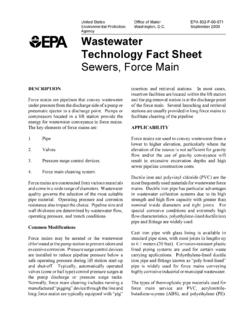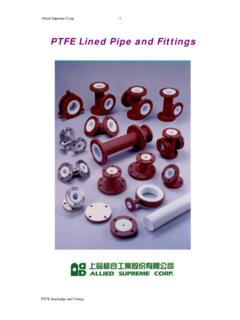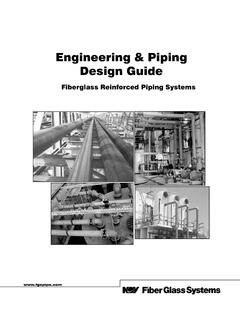Transcription of United States Environmental Protection Agency Wastewater ...
1 United StatesEnvironmental Protection AgencyWastewater Technology Fact SheetAerated, Partial Mix LagoonsDESCRIPTIONP artial mix lagoons are commonly used to treatmunicipal and industrial wastewaters. This technologyhas been widely used in the United States for at least40 years. Aeration is provided by either mechanicalsurface aerators or submerged diffused aerationsystems. The submerged systems can includeperforated tubing or piping , with a variety of aerated lagoons, oxygen is supplied mainly throughmechanical or diffused aeration rather than by algalphotosynthesis. Aerated lagoons typically areclassified by the amount of mixing provided. A partialmix system provides only enough aeration to satisfy theoxygen requirements of the system and does notprovide energy to keep all total suspended solids (TSS)in suspension.
2 In some cases, the initial cell in a system might be acomplete mix unit followed by partial mix and settlingcells. Most energy in complete mix systems is used inthe mixing function which requires about 10 times theamount of energy needed for an equally-sized partialmix system to treat municipal wastes. A complete mixwastewater treatment system is similar to the activatedsludge treatment process except that it does not includerecycling of cellular material, resulting in lower mixedliquor suspended solids concentrations, which requiresa longer hydraulic detention time than activated solids in partial mix lagoons are kept insuspension to contribute to overall treatment. Thisallows for anaerobic fermentation of the settled mix lagoons are also called facultative aeratedlagoons and are generally designed with at least threecells in series, with total detention time dependent onwater temperature.
3 The lagoons are constructed tohave a water depth of up to 6 m (20 ft) to ensuremaximum oxygen transfer efficiency when using diffusedaeration. In most cases, aeration is not applieduniformly over the entire system. Typically, the mostintense aeration (up to 50 percent of the total required)is used in the first cell. The final cell may have little orno aeration to allow settling to occur. In some cases, asmall separate settling pond is provided after the finalcell. Diffused aeration equipment typically providesabout to 4 kg O2/kW-hour (6 to lbs O2/hp-hour) and mechanical surface aerators are rated at kg O2/kW-hour ( to lbs O2/hp-hour).Consequently, diffused systems are somewhat moreefficient, but also require a significantly greaterinstallation and maintenance lagoons can reliably produce an effluent withboth biological oxygen demand (BOD) and TSS < 30mg/L if provisions for settling are included at the end ofthe system.
4 Significant nitrification will occur during thesummer months if adequate dissolved oxygen isapplied. Many systems designed only for BODremoval fail to meet discharge standards during thesummer because of a shortage of dissolved of ammonia and BOD removal occursimultaneously and systems can become oxygen achieve nitrification in heavily loaded systems, pondvolume and aeration capacity beyond that provided forBOD removal are necessary. Oxygen requirements fornitrification are more demanding than for BOD is generally assumed that kg of oxygen is requiredto treat 1 kg of BOD. About 5 kg of O2 aretheoretically required to convert 1 kg of ammonia aerated lagoon is well suited for municipal andindustrial wastewaters of low to medium such systems are somewhat land intensive,theyrequire much less area than a facultative lagoon and canprovide a better level of treatment.
5 Operation andmanagement requirements are also less than thoserequired for activated sludge and similar physical modification to an aerated lagoon usesplastic curtains supported by floats and anchored to thebottom to divide existing lagoons into multiple cellsand/or serve as baffles to improve hydraulic recently developed approach suspends a row ofsubmerged diffusers from flexible floating booms whichmove in a cyclic pattern during aeration activity. Thisserves to treat a larger volume with each aeration is periodically recycled within the system toimprove performance. If there is sufficient depth foreffective oxygen transfer, aeration is used to upgradeexisting facultative ponds and is sometimes used on aseasonal basis during periods of peak wastewaterdischarge to the lagoon ( seasonal food processingwastes).
6 ADVANTAGES AND DISADVANTAGESA dvantages and disadvantages of aerated, partial mixlagoons are listed below:Advantages Require less land than facultative lagoons. Require much less land than facultative ponds,depending on the design conditions. An aerated lagoon can usually discharge throughoutthe winter while discharge may be prohibited froman ice-covered facultative lagoon in the sameclimate. Sludge disposal may be necessary but the quantitywill be relatively small compared to other secondarytreatment Aerated lagoons are not as effective as facultativeponds in removing ammonia nitrogen orphosphorous, unless designed for nitrification. Diurnal changes in pH and alkalinity that affectremoval rates for ammonia nitrogen andphosphorous in facultative ponds do not occur inaerated ponds.
7 Aerated lagoons may experience surface iceformation. Reduced rates of biological activity occur duringcold weather. Mosquito and similar insect vectors can be aproblem if vegetation on the dikes and berms is notproperly maintained. Sludge accumulation rates will be higher in coldclimates because low temperature inhibits anaerobicreactions. Requires energy CRITERIAE quipment typically required for aerated lagoonsincludes the following: lining systems, inlet and outletstructures, hydraulic controls, floating dividers andbaffles, aeration system should have at least three cells in serieswith each cell lined to prevent adverse groundwaterimpacts. Many States have design criteria which specifydesign loading, the hydraulic residence time, and theaeration requirements.
8 Pond depths range from to6 m (6 to 20 ft), with 3 m (10 ft) the most typical (theshallow depth systems usually are converted facultativelagoons). Detention times range from 10 to 30 days,with 20 days the most typical (shorter detention timesuse higher intensity aeration). The design of aeratedlagoons for BOD removal is based on first-orderkinetics and the complete mix hydraulics model. Eventhough the system is not completely mixed, aconservative design will result. The model commonlyused is:Ce =Co/[1 + (KT)(t)/n]nwhere: Ce = effluent BODCo = influent BODKT = temperature dependent rate constant K20 = rate constant at 20 CK20 = d-1 at 20 C = temperature coefficient ( )KT = K20 (T-20)T = temperature of watert = total detention time in systemn = number of equal sized cells in systemDetention times in the settling basin or portion of a basinused for settling of solids should be limited to two daysto limit algae growth.
9 The design of inlet and outletstructures should receive careful BOD removal can range up to 95 percent. EffluentTSS can range from 20 to 60 mg/L, depending on thedesign of the settling basin and the concentration ofalgae in the effluent. Removal of ammonia nitrogen inaerated lagoons is usually less effective than infacultative lagoons because of shorter detention of ammonia can occur in aerated lagoonsor if the system is specifically designed for that removal is also less effective than infacultative lagoons because of more stable pH andalkalinity conditions. Phosphorus removals of about 15to 25 percent can be expected with aerated of coliforms and fecal coliforms can beeffective, depending on detention time and may be necessary if effluent limits are lessthan < 200 MPN/100 aerated lagoon system is simple to operate andreliable in performance for BOD removal.
10 TSSremoval can be influenced by the presence of algae inthe lagoon , but generally is acceptable. The service lifeof a lagoon is estimated at 30 years or AND MAINTENANCEL imitationsDepending upon the rate of aeration and theenvironment, aerated lagoons may experience iceformation on the water surface during cold weatherperiods. Reduced rates of biological activity also occurduring cold weather. If properly designed, a systemwill continue to function and produce acceptableeffluents under these conditions. The potential for iceformation on floating aerators may encourage the use ofsubmerged diffused aeration in very cold climates. Theuse of submerged perforated tubing for diffusedaeration requires maintenance and cleaning on a routinebasis to maintain design aeration rates.














